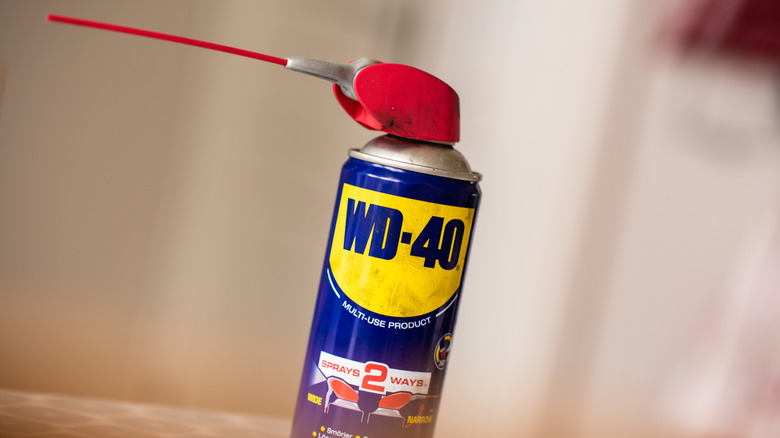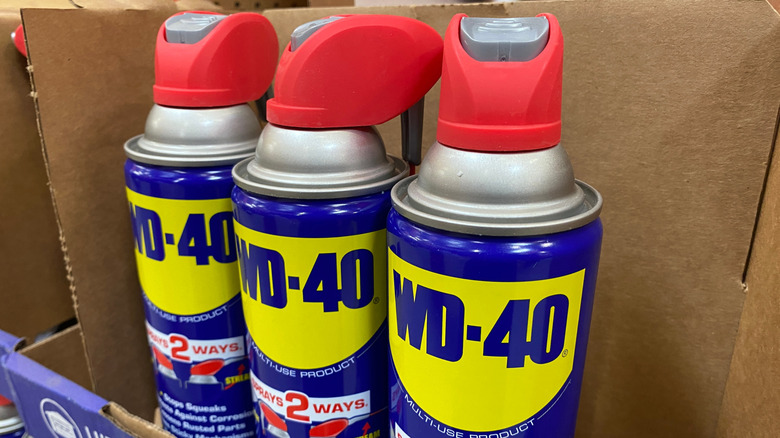Using WD-40 On Plastic Is A Big Mistake And Here's Why
WD-40 is one of those miracle household items that we all sort of take for granted. But creating the now-ubiquitous lubricating oil wasn't easy at all. In fact, the very name of the product advertises the multiple attempts it took to perfect. San Diego-based Rocket Chemical Company created WD-40 back in 1953 while trying to develop rust-prevention solvents and degreasers for the aerospace industry. In order to find exactly the right formula for their water displacing (hence "WD") oil, the small staff of three tried 40 different versions before they landed on the final mixture. To commemorate their determination, they added that very number to the name, and WD-40 — which stands for Water Displacement perfected on the 40th try — quickly took off.
Over the years, WD-40 went from being used as a protective outer skin for missiles to a massively popular consumer product that has a surprisingly rich and varied history. WD-40 was sent to soldiers in Vietnam to help keep their weapons in working order, and was sent to Floridians affected by Hurricane Carla in 1961 in order to recondition machinery and cars damaged by the storm. The company itself even maintains a list of a purported 2,000+ uses for this adaptable spray, and claims that WD-40 has been used by a bus driver to remove a python that had coiled itself around the underside of his bus and by police officers to dislodge a "naked burglar" trapped in an air conditioning vent. As such, you might think that there's nothing WD-40 can't do. But you'd be wrong because using the oil on certain types of plastic is a big mistake.
WD-40 and certain types of plastic don't mix
WD-40 is marketed as a "multi-use" product and its impressive history certainly backs up that claim. But that doesn't mean it can be used for everything. While WD-40 can be applied to many forms of plastic, there are certain instances where you should avoid using it altogether. Applying the oil to PVC (polyvinyl chloride) pipe, for instance, might seem like a good idea in order to lubricate the various parts before trying to fit them together, but doing so would be a bad idea as the hydrocarbons in WD-40 break down the polymers in PVC plastic as well as polycarbonate and polystyrene plastics.
Polymers are substances that are composed of large molecules called macromolecules, which are bonded together in long chains. Polymers can be classified as two types: amorphous and crystalline. The amorphous types are made up of atoms that hang together in a loose, random, and unpredictable structure and include polymethylmethacrylate, polycarbonate, PVC, and many more. It's these amorphous polymers that don't interact well with WD-40 since a significant proportion of the oil is made of aliphatic hydrocarbons which erode the amorphous polymers.
That basically means you should never use WD-40 on polycarbonate (which is often used in the lenses for eyeglasses), PVC pipe, or even polystyrene. Amorphous polymers are also used in baby bottles, optical discs, and LCD screens — not that you'd be planning to spray down your baby bottles with WD-40 any time soon, but still. Crystalline plastics, such as polypropylene, polyethylene, polyester, and nylon, hold up much better when exposed to WD-40, but it's probably best to try to refrain from using the liquid on most plastics. The company does make specific products which can be safely used on plastics, but the standard WD-40 is best reserved for other tasks.

